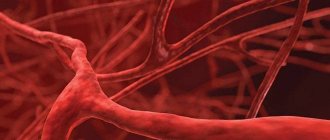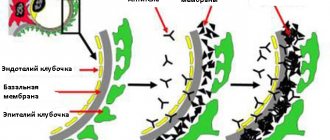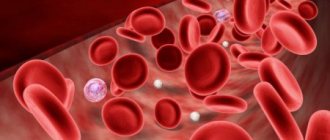Types of blood sepsis
Experts classify blood sepsis (symptoms in adults manifest differently) depending on the main pathogen, the mechanism of development of the disease and the site of infection.
Taking into account the pathogen, several forms of the disease can be named: streptococcal, staphylococcal, pneumococcal, meningococcal, colibacillary, pseudomonas, anaerobic sepsis. Depending on the mechanism of development of the disease, several forms occur.
The most commonly diagnosed are the following:
- The fulminant form progresses rapidly. After 2-3 days, symptoms increase and there is a risk of death.
- Recurrent sepsis is considered one of the milder forms. Periods of deterioration alternate with periods of complete health.
- Acute develops quickly, progression of symptoms occurs over 5-7 days.
- The subacute type of the disease involves a gradual increase in symptoms over 2-3 months.
- The chronic type occurs hidden, the symptoms gradually worsen. Progression continues over 10-12 months.
Depending on the area where microorganisms allegedly entered the bloodstream, experts distinguish several forms of the disease. The surgical and postoperative type of sepsis occurs as a result of an abscess breaking inside or an unsuccessful intervention on the skin or internal organs.
However, symptoms appear after some time. With complications arising after childbirth or cesarean section, obstetric and gynecological sepsis develops. This type of disease is very difficult and often causes death.
Urosepsis becomes a consequence of diseases of the urinary system. In this case, a purulent focus is almost always present in the bladder, urethra or kidneys. The otogenic type of the disease is very dangerous, often leading to acute inflammation of the meninges, and develops in diseases of the auditory canal and inner ear.
Rhinogenic sepsis occurs when a purulent focus is localized in the nasal or maxillary sinuses. It is quite rare.
Severe sepsis: symptoms
If left untreated, sepsis will eventually cause damage to various organs. Here are some examples.
If the blood poisoning has spread to the liver , it can lead to jaundice (a sign of yellowing of the skin).
Sepsis can impair kidney function , causing a decrease in the amount of urine produced, leading to complete kidney failure.
Blood circulation worsens due to increased blood clotting. This can cause small blood clots to narrow or block tiny blood vessels (capillaries). As a result, tissues and organs no longer receive sufficient oxygen.
Thus, blood poisoning can cause symptoms characterized by acute organ failure, such as stroke, kidney failure, or heart attack.
Stages and degrees of blood sepsis
When any type of disease develops, experts divide it into several stages and degrees.
The specific type of condition does not matter, since there is a single classification of stages or degrees of its development:
- First, or the initial stage manifests itself differently in patients. Some say that there are no symptoms, others notice changes in internal organs, lack of appetite and other general signs that cannot be associated specifically with sepsis.
Blood sepsis, the first stage is manifested in lack of appetite and other general symptoms. - The second , or progressive stage, appears more clearly. The patient shows signs of infection, the condition rapidly worsens, and internal organs suffer. It is at this stage that it is possible to determine the location of the pathogen (genitourinary system, ear canal, nasal sinuses, skin).
- The acute degree is accompanied by progression of symptoms, the appearance of complications from the heart, lungs, and brain.
- The advanced stage is considered very severe. It is quite difficult to cure the patient, since all organs and systems are affected, and pronounced external signs of the condition appear.
- The terminal stage is the most dangerous. In this case, all processes in the patient’s body are disrupted, he loses consciousness, delirium, hallucinations and other symptoms are observed. The probability of death when the disease reaches this stage is very high.
With different forms of the disease, the signs of one or another stage can be pronounced or smoothed out, but they are always present, so the doctor has the opportunity to determine at what stage the condition is now.
How dangerous is sepsis - the consequences of the disease
Starting from the first stage of development, sepsis entails a number of irreversible processes. The consequences of sepsis are characterized by severe changes in the body.
Bacteria entering an organ cause infectious shock (a severe multisystem disease that poses a threat to human life). At the same time, blood pressure rapidly decreases, which requires immediate resuscitation. Actions are performed within 40-60 minutes, otherwise death is inevitable. In some cases, death occurs within 10 minutes.
The foundation of symptoms of infectious toxic shock is characterized by the following features:
- Constant chills associated with a pathological condition consisting in the inability of the circulatory system to deliver the required amount of blood to the organs.
- Violation of energy supply to intracellular processes.
- Clouding of consciousness, vegetative states.
- At the site of the wound or other damage, blueness and pallor of the skin are observed.
- Stool disorders, vomiting, nausea.
Blood sepsis, the consequences of which are inevitable, may also have other signs resulting from infection and intoxication of the body:
- inflammation of lung tissue;
- bleeding;
- possible gangrene, abscesses, pleurisy, pulmonary infarction;
- cystitis and kidney inflammation (due to common infections);
- sudden blockage of the vascular bed by an embolus (a particle brought with the bloodstream);
- thrombosis;
- necrosis of soft tissues as a result of circulatory disorders;
- development of heart failure;
- meningitis (caused by damage to the lining of the brain);
With such complications, the risk of death increases sharply.
Symptoms of blood sepsis
Blood sepsis (symptoms in adults may occur immediately or somewhat later) manifests itself in the form of external and general signs that worsen the patient’s condition. At the initial stage, the respiratory cycle increases to 20 or more inhalations and exhalations over 1 minute. When palpating the pulse, you can note its increase to 100 beats/min or more.
The next sign will be an elevated body temperature exceeding 380C. The patient feels weakness, aches throughout the body, refuses food, but is constantly thirsty. He has a headache, the person becomes irritated, and his performance is significantly reduced.
As the disease progresses, other manifestations appear. The skin becomes pale, sometimes even marbled, cold to the touch, and damp. With the development of septic shock, blood pressure decreases to critical levels. The patient's consciousness becomes clouded, he has poor spatial orientation, does not remember recent events and confuses the names of loved ones.
In advanced cases, a specific round-shaped rash of varying sizes appears on the skin. The edges of the rash are very clear, the bubbles are filled with cloudy or transparent liquid. Such a rash is very specific and occurs only with the development of sepsis, so its presence can serve as a reason for making a diagnosis.
The patient's appearance also attracts attention. The face is haggard, sallow, yellowish or greenish in color. In the chronic course of the disease, the patient loses weight, experiences constipation or loose stools, nausea and vomiting, which do not bring relief. Gradually, the human body becomes exhausted, and anorexia often develops.
The patient's tongue becomes dry, a white coating appears on it, digestion is disrupted, the skin is dry, and areas of peeling and irritation are found. Sometimes there is no rash or other acute symptoms, but the body temperature is constantly rising, which should also be a cause for concern.
Chills
Chills often accompany fever. If you notice such a symptom, be sure to tell your doctor. Chills are purely subjective - the patient feels it, but the doctor cannot notice it from the outside. However, this symptom is also associated with the flu, which sometimes causes problems with making an accurate diagnosis. You should exercise extreme caution if you have chills and be aware of the possibility of sepsis.
Volvo announces partnership with Waymo: a new step towards autonomous cars
Test your school knowledge and find out how erudite you are: test
Dress up your look in a minute: 3 of the hottest accessories for this summer
Causes of blood sepsis
Blood sepsis causes a variety of symptoms in adults, but to establish an accurate diagnosis it is necessary to identify the predisposing factor of the disorder. Depending on the type of disease, experts identify various causes of its occurrence.
| Type of disease | Probable Causes |
| Pneumococcal | Develops as a result of penetration of pneumococci into the bloodstream during acute or chronic pneumonia |
| Staphylococcal | Caused by staphylococci, which penetrate into the blood from purulent foci located on the body or internal organs |
| Streptococcal | Streptococci lead to the development of sepsis quite often with injuries, burns or sore throat |
| Anaerobic | It is provoked by anaerobic bacteria that penetrate the blood from the external environment or from internal organs |
| Meningococcal | The cause is meningitis, which affects the meninges |
| Pseudomonas | Pseudomonas aeruginosa often provokes sepsis and can be introduced during operations or other manipulations in a medical institution |
| Uroseptic | The cause is cystitis, bartholinitis, pyelonephritis, urethritis, purulent foci in the bladder |
| Obstetrics and gynecology | The result of complicated births, caesarean sections, abortions and miscarriages |
| Rhinogenic | Occurs due to the formation of a purulent focus in the maxillary or nasal sinuses |
| Surgical | Symptoms appear when the abscess breaks inside with the subsequent spread of infection in the bloodstream |
| Postoperative | Often develops after surgery with violation of the rules of postoperative care |
| Otogenic | Consequence of otitis, complicated by purulent inflammation |
There are also common causes that can become provoking factors and contribute to the penetration of pathogens into the bloodstream.
These include violation of the rules of asepsis and antisepsis when treating wounds and burns, non-compliance with doctor’s recommendations, weakening of immune forces, resistance of the pathogen to the action of medications. In addition, the cause may be the wrong choice of antibacterial medications in the treatment of acute purulent infections.
Prevention of blood poisoning
Preventive actions are based on the following principles:
- Local surgical treatment of infected wounds and excision of a purulent focus.
- The use of anti-putrefactive agents that maximally protect against decomposition processes on the surface of an open wound during surgery or other medical procedures.
- Timely removal of catheters.
- Accurate selection of antibiotics (it is important not to forget that pathogenic microbes develop resistance to medications).
- Compliance with personal hygiene rules, disinfection of instruments, cleaning of the premises.
- Vaccinations of people with organ pathologies, immune deficiency, and chronic forms of diseases.
The risk of disease will directly depend on the method of infection and the type of pathogen. For example, with salmonellosis (acute intestinal infection), blood poisoning will occur only in some patients. In clinical diseases of microbial origin, the risks of sepsis in patients undergoing hospital treatment are very high.
Blood poisoning cannot be equated with the presence of bacteria in the blood. Bacteremia manifests itself in mild forms of infectious diseases and can lead to the development of septicemia and septicopyemia, stages of sepsis development.
Diagnosis of blood sepsis
Blood sepsis is considered a dangerous and serious disease, therefore, when the first symptoms appear in adults, it is necessary to immediately consult a doctor for a diagnostic examination. The first stage of diagnosis will be an examination of the patient, his skin and visible mucous membranes. This allows you to get a general picture of the disease.
The doctor must count the pulse and breathing rate and record the data obtained. After this, he measures body temperature and blood pressure.
Next, a clinical examination of blood and urine is required to identify signs of inflammation. Usually, a large number of leukocytes are present in the urine, and in the blood their level is 5-10 times higher than normal. In addition, the analysis shows an increase in the erythrocyte sedimentation rate, which also confirms infection.
If you have frequent loose stools, your doctor will order a stool test to rule out the possibility of an intestinal infection. The most important result is the result of a bacteriological blood test. The specialist takes a sample of material from the patient’s vein, and in the laboratory the blood is cultured on a nutrient medium.
After some time, the laboratory technician can tell which pathogen caused the sepsis. Such a Study is considered standard and is carried out in any medical institution in large and small cities of Russia.
Typically, the patient does not have to pay for these tests. But in some institutions they are done quite quickly, and the cost ranges from 200-300 rubles. After receiving the results of all tests, the doctor prescribes an additional examination.
The most informative methods will be the following:
- X-ray examination of the lungs to confirm the presence of foci of pneumonia or refute the assumption. The cost in different clinics across the country is 100-200 rubles. Diagnostics are carried out in any institution.
- Ultrasound of the kidneys , bladder and organs of the reproductive system also allows us to exclude some of the doctor’s assumptions. It is carried out quickly in any medical institution, does not cause discomfort and is highly accurate. The diagnostic price is 300-500 rubles. depending on the region of the country.
- Magnetic resonance imaging is usually performed only in large cities where there are multidisciplinary clinics. The price of the study starts from 2000 rubles. and can reach 10,000 rubles. The method allows you to detect even small foci of inflammation and establish the cause of sepsis.
Hardware techniques are painless, highly accurate, and therefore are often used as additional methods. But in small towns where there is no opportunity to conduct such an examination, doctors make a diagnosis based on the result of a bacteriological blood test.
Diagnosis of blood poisoning
In order to accurately determine how to treat blood sepsis, it is necessary to establish the source of infection and the type of pathogen that has entered the bloodstream.
To do this, a blood test is performed, which is taken from different veins, and the isolated microorganisms are inoculated into a nutrient medium. At the same time, their sensitivity to antibiotics is determined.
In severe cases, a rapid analysis is performed, during which the genetic material of the pathogen is isolated in the blood, so that within 1.5 hours it is possible to identify 25 types of bacteria or fungi that cause sepsis.
When to see a doctor
It is necessary to contact a specialist at the initial stage of the disease, since in this case it is possible to completely cure the patient in a short time and avoid complications. First, the patient should contact a general practitioner, who will refer a surgeon, an infectious disease specialist, and a hematologist for consultation.
If the result of a bacteriological blood test is positive, you must visit a doctor urgently. The reason for contacting will also be an increase in the level of leukocytes and erythrocyte sedimentation rate. Only a therapist can refer the patient for further diagnostics, so it is important to visit him in a timely manner.
Diagnostic measures
Diagnostic criteria for early sepsis
To quickly prescribe treatment for sepsis, it is necessary to accurately determine the route through which the infection entered the body. Only with timely diagnosis can it be determined at an early stage whether it is sepsis or a short-term infection. To determine this pathology, the following criteria for sepsis must be taken into account:
- the primary focus, which is interconnected with the lymphatic and circulatory system;
- entry of microbes into the blood in large quantities;
- the emergence of secondary foci from which pathogens also infect the blood;
- sluggishness of the immune system.
Taking these factors and symptoms of the disease into account, the doctor makes a diagnosis.
Prevention of blood sepsis
To prevent the development of the disease, it is necessary to listen to the recommendations of doctors. The first and most important method of prevention is timely treatment of any inflammatory diseases. This will minimize the risk of infection entering the systemic circulation. An advanced disease will certainly lead to complications, so you should not ignore it.
The second method will be to follow the rules after opening the abscess or performing surgery. The open wound should not be allowed to come into contact with an environment contaminated with water. It is strictly forbidden to remove the bandage at home and try to treat the wound without the appropriate experience and skills.
In addition, you should not refuse vaccination, since in most cases it helps prevent serious illnesses. Additionally, you should follow the rules of personal hygiene, preventing the proliferation of microbes on the skin.
A good method of prevention would be to strengthen the immune system through proper nutrition, taking vitamins and immunostimulants, playing sports and hardening. This will allow the body to fight the infection once it enters the bloodstream.
Causes of sepsis
The development of sepsis most often occurs against the background of weakened immunity. The cause of infection can be viral diseases, for example an infection of the digestive system. The process starts precisely in the presence of a focus of infection and repeated entry into the blood of the same pathogen. They can become staphylococci, streptococci, fungi and other purulent pathogens.
The chances of developing sepsis increase when the body's defenses are weakened, especially in the presence of factors that contribute to the suppression of the immune system: frequent stress, poor environment. Other factors include:
- surgical operations accompanied by blood loss;
- oncology;
- AIDS;
- blood diseases.
Taking immunosuppressive medications plays a negative role in the development of infection.
People with a history of chronic diseases are at increased risk.
In this case, even the most harmless illness can provoke blood poisoning: a weakened body is not able to fight infectious pathogens that begin to actively multiply, developing resistance to drugs.
Treatment methods for blood sepsis
Blood sepsis (symptoms in adults can progress quite quickly) provokes serious complications in the absence of proper treatment. Today, specialists use medications from different groups, alternative medicine recipes and other ways to combat the disease.
Medications
The main focus of therapy for blood poisoning is to remove toxins from the body and prevent further proliferation of microbes. To eliminate signs of sepsis, the doctor prescribes antibiotics, intravenous drip solutions, painkillers, and drugs to restore heart rhythm to the patient.
They are:
- Ceftriaxone is a broad-spectrum antibiotic that allows you to fight various pathogens. For sepsis, intramuscular and intravenous injections are prescribed 2 times a day. The dosage of the drug per administration is 1-2 g, depending on the severity of the condition. The course of treatment lasts from 10 to 14 days. The price of 1 bottle of medicine is 40-60 rubles. The drug is effective, well tolerated, and quickly destroys the pathogen.
- Ringer's solution is a detoxifying agent that has a positive effect on the liver and kidneys. Helps restore water balance, cleanses the blood, facilitates the functioning of the kidneys and liver, and prevents dehydration. The patient is infused with 200 to 500 ml of solution per day using a dropper. Treatment lasts at least 10 days. The price of the product is 180 rubles. per bottle 200 ml.
- Reosorbilact is an effective detoxifying agent that restores water balance and blood composition, preventing the spread of toxins in the body. It is considered effective, used at any stage of sepsis, and prevents the development of septic shock. The duration of the course is at least 10 days, the daily dosage is from 200 to 400 ml. The medicine is administered intravenously. The price of the medicine is 230 rubles. per bottle 200 ml.
- Reopoliglyukin – an effective drug in the form of a solution that allows you to remove toxins from the blood and restore rheological properties. It is highly effective and is administered intravenously using a dropper 1-2 times a day in a dosage of 200-500 ml. Duration of use – from 10 to 14 days. The price of a 400 ml bottle is 120-140 rubles.
- Cordarone is an antiarrhythmic drug used to restore heart rhythm. Available in solution, in ampoules of 3 ml. It is administered by drop after dissolution in 200 ml of 5% glucose or 0.9% sodium chloride. The procedure is carried out for 3-5 days in a row, 1 time per day. The drug is effective and rarely causes negative reactions when used correctly. The price of one ampoule ranges from 100-150 rubles.
- Ketorol is a pain reliever used to alleviate the patient’s condition and normalize sleep. Helps reduce pain, the person calms down, and the condition returns to normal. Additionally, it has antipyretic and anti-inflammatory properties. It is administered intramuscularly in an amount of 1 ml 1 to 3 times a day. Duration of use – 5-7 days. The cost of 1 ampoule of the medicine is 30-40 rubles.
Such remedies are included in the classical treatment regimen. Additionally, the patient may be prescribed medications to normalize the functions of internal organs, but the decision in each case is made individually. If complications arise, the specialist makes changes to the classic regimen and prescribes other remedies.
Traditional methods
Alternative medicine recipes are not able to cope with sepsis, but they are allowed to be used to alleviate the general condition and prevent complications. Usually, experts prescribe herbal decoctions and infusions that have a healing effect and cannot harm the patient.
Traditional recipes:
- Chamomile infusion is a natural antiseptic and antibacterial agent. It’s easy to prepare: 300 ml of boiling water will require 2 g of dry herb, the medicine should be infused for 20 minutes, and taken warm after straining 1 to 3 times a day. Duration of use – 7 days. The infusion helps remove toxins from the body. Normalize intestinal function, improve digestion, prevent loose stools.
- Decoction of mint and lemon balm – a natural sedative that helps eliminate anxiety, insomnia, and improve general condition. Additionally, the product normalizes digestion, reduces temperature, removes toxins, and restores water balance. Preparing the decoction is simple: Separate 5 g of each herb. Add 1 liter of boiling water. Cook for 3 minutes. Leave for 30 minutes. Filter. Take 100 ml decoction three times a day for 5 days. The drug is not used in case of a critical decrease in blood pressure.
- Nettle decoction perfectly cleanses the blood, strengthens blood vessels, helps restore rheological properties, and prevents the spread of infection. You can prepare it from 1 tbsp. l. dry nettle and 300 ml of water, cook for 5 minutes, leave for 1 hour. Divide the filtered product into 3 parts and drink throughout the day.
Duration of treatment – 10 days. It is worth remembering that such remedies will not help cure the patient, but will alleviate his condition. Each recipe has contraindications and side effects, so its independent use is strictly contraindicated.
Other methods
Other methods of treating sepsis include diet, plasma or albumin infusion, and wound drainage (if there is one and it has become the cause of infection).
Each method has its own characteristics:
- Following a diet is considered an important way, since this way the patient can reduce the load on the liver and other organs of the digestive system. Food should be light, low-fat, nutritious. The diet should contain chicken meat, poultry liver, dairy products, a small amount of stewed vegetables, and eggs. Portions should be small. It is important to drink a lot of liquid in the form of fruit drinks, compotes, and warm tea. The specialist makes an individual decision on the timing of the diet.
- Intravenous drip administration of albumin or plasma helps restore blood composition and improve the condition. Plasma of the corresponding group is administered at 150-200 ml per day, once every 3-4 days. In total, the course consists of 4-5 procedures. When using albumin, the procedure can be carried out daily for a week, a single dose is 100 ml.
- Drainage of a purulent wound is indicated in cases where it was the cause of sepsis. The doctor prescribes rinsing, ointments that stimulate healing, examines the tissue daily, uses other medications, or extends the course. This minimizes the risk of re-infection and alleviates the patient’s general condition.
Such methods are not considered basic and are not able to cure sepsis, but in combination with medications they bring good results.
Low blood pressure
Low blood pressure is considered one of the most serious signs of infection. It may be associated with septic shock, the most critical stage. Low blood pressure occurs when blood vessels lose fluid, veins and arteries relax, causing blood to not circulate in the body as well as usual. The manifestation of such a symptom should be taken as a signal for immediate action.
A puzzle with complex calculations? Not at all! Children cope in no time
Remained a handsome man: the prince from “The Princess and the Pea” Andrey Podoshyan
Waiters, special smoking cars. How trains have changed over a hundred years
Possible complications
If left untreated, the patient may develop kidney, liver, heart failure, severe bronchitis and pneumonia, brain disorders, convulsions, and severe exhaustion.
The most severe complication is considered to be death, which is the result of advanced sepsis that develops after a serious illness in a patient with a weakened immune system. Blood sepsis is a dangerous and serious disease. Symptoms in adults manifest differently, but treatment is required.
Article design: Oleg Lozinsky











